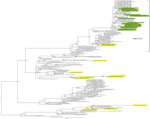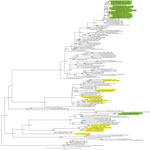Volume 19, Number 10—October 2013
Dispatch
Reassortant Avian Influenza A(H5N1) Viruses with H9N2-PB1 Gene in Poultry, Bangladesh
Abstract
Bangladesh has reported a high number of outbreaks of highly pathogenic avian influenza (HPAI) (H5N1) in poultry. We identified a natural reassortant HPAI (H5N1) virus containing a H9N2-PB1 gene in poultry in Bangladesh. Our findings highlight the risks for prolonged co-circulation of avian influenza viruses and the need to monitor their evolution.
Bangladesh has one of the highest reported number of outbreaks of highly pathogenic avian influenza (HPAI) (H5N1) in poultry (1). As of May 26, 2013, a total of 548 outbreaks of HPAI (H5N1) have been reported (1); these outbreaks have resulted in serious economic repercussions in the poultry sector in this country. Furthermore, 7 cases of human infection with HPAI (H5N1) were confirmed, most recently a fatal case in a 2-year-old child in April 2013 (2).
In addition to the HPAI (H5N1) virus, the H9N2 subtype is widely circulating in poultry in Bangladesh, which raises concerns about the possible implications of the extensive co-circulation of these viruses (3,4). Their coexistence in the same susceptible population is likely to generate appropriate conditions for the emergence of novel reassortant variants, with unknown epizootic and zoonotic potential. We characterized the complete genome of 18 HPAI (H5N1) virus strains from Bangladesh and report the identification and characterization of a novel natural reassortant HPAI (H5N1) virus that contains an H9N2-PB1 gene in poultry.
A total of 18 tracheal and 1 cloacal samples were collected from chickens in 14 layer farms (15 samples) and 2 live-bird markets (4 samples) in 13 districts of Bangladesh during December 2011–April 2012. The samples were submitted by the Department of Livestock Services Dhaka to the World Organisation for Animal Health/United Nations Food and Agriculture Organization Reference laboratory for Avian Influenza in Italy for confirmatory diagnosis and genetic analysis. All samples tested positive for the H5N1 subtype by real-time reverse transcription PCR (rRT-PCR) (5) and virus isolation (http://www.oie.int/fileadmin/Home/eng/Health_standards/tahm/2.03.04_AI.pdf). Because the H7 subtype is also notifiable and the H9N2 subtype circulates in the poultry population in Bangladesh (3), samples were tested for these subtypes as well; results were negative. Epidemiologic information for these viruses is provided in the Table.
The complete genome of 18 HPAI (H5N1) isolates and the hemagglutinin (HA) gene of 1 virus (A/chicken/Bangladesh/12VIR-7140-9/2012) were successfully sequenced, as described (6). The nucleotide sequences obtained in this study have been submitted to GenBank (accession nos. KC616462–KC616606). Maximum-likelihood (ML) trees were estimated for all 8 gene segments (HA, neuraminidase [NA], nucleoprotein [NP], basic polymerase protein [PB] 1 and 2, polymerase [PA], matrix [M], and nonstructural [NS]) by using the best-fit general time reversible + I + Γ4 model of nucleotide substitution in PhyML (7). A bootstrap resampling process (1,000 replications) using the neighbor-joining method was used to assess the robustness of individual nodes of the phylogeny, incorporating the ML substitution model defined above.
Analysis of the topologic differences between the 8 ML phylogenetic trees revealed that an intersubtype reassortment event took place and caused replacement of the PB1 gene of 2 of the HPAI (H5N1) viruses from Bangladesh (A/chicken/Bangladesh/12VIR-7140-7/2012 and A/chicken/Bangladesh/12VIR-7140-16/2012) with the PB1 gene of an H9N2 subtype virus. In the HA gene, all the viruses from Bangladesh analyzed fell within clade 2.3.2.1 (Figure 1) and had high similarity (98.2%–99.7%) to viruses from Bangladesh and India identified in 2011 (10). Phylogenetic analysis of the NA, NP, PB2, PA, M, and NS genes (Technical Appendix) confirmed the clustering observed for the HA gene; all 18 fully sequenced viruses grouped together and with viruses from Bangladesh and India identified in 2011.
A close examination of the PB1 tree topology revealed the existence of a diversified origin of this internal gene for the viruses analyzed. In particular, the PB1 gene of 16 of the 18 viruses we characterized clustered as described for the other 7 genome segments, whereas phylogeny of A/chicken/Bangladesh/12VIR-7140-7/2012 and A/chicken/Bangladesh/12VIR-7140-16/2012 revealed that their PB1 gene derived from H9N2 subtype viruses. In particular, the PB1 gene of these 2 HPAI (H5N1) strains belongs to a cluster composed by subtype H9N2 viruses from Bangladesh and India identified during 2008–2011 and had the highest similarity (96.9%–97.1%) with the Indian strain A/chicken/Tripura/105131/2008. Genetic identity between A/chicken/Bangladesh/12VIR-7140-7/2012 and A/chicken/Bangladesh/12VIR-7140-16/2012 ranged from 98.1% for the PA gene to 99.3% for the NP gene; the 2 viruses can be distinguished from each other by a total of 37 aa differences found in the 13 viral proteins, with the PA gene possessing most (16) of these substitutions. Furthermore, distinct epidemiologic origins characterize these viruses; the A/chicken/Bangladesh/12VIR-7140-7/2012 virus was identified in a chicken farm located in Sirajganj district in January 2012, whereas the A/chicken/Bangladesh/12VIR-7140-16/2012 strain was detected 2 months later (March 2012) from organs collected in Kaptan Bazar in Dhaka (Table), which is 126 km from Sirajganj district. By evaluating these findings, we can theorize that a single reassortant event occurred and then the viruses evolved independently or that 2 independent reassortant events took place.
The genetic characterization of the 2 natural reassortant viruses we identified was remarkably different from that of previously identified reassortant viruses possessing subtype H9N2 genes in an HPAI (H5N1) backbone virus identified in Asia (8,9). Our results imply that these natural reassortments occurred independently. Indeed, the phylogenic trees for the HA and PB1 genes (Figures 1, 2) demonstrate that the 2 viruses from Bangladesh can be distinguished from the H5N1/H9N2 reassortant strains identified in Tibet and China.
The pathogenicity of 3 subtype H5N1 viruses (the 2 H5N1/H9N2 7:1 reassortants and the H5N1 A/chicken/Bangladesh/12VIR-7140–12/2012 isolate) was determined by intravenous pathogenicity index in specific pathogen–free chickens. This value was 3.0 for all the viruses tested, confirming the isolates can be considered highly pathogenic, according to the World Organisation for Animal Health definition (www.oie.int/fileadmin/Home/eng/Health_standards/tahm/2.03.04_AI.pdf).
Although reassortment represents a major mechanism behind the emergence and evolution of the HPAI (H5N1) in Asia (11,12), data suggest that, in the past decade, these viruses have only sporadically provided the backbone for generation of novel intersubtype reassortants (8,9,13,14). This is surprising considering the prolonged and extensive co-circulation of subtype H5N1 and H9N2 viruses in poultry in Asia; it is unclear whether the limited evidence is because of insufficient surveillance or the low capacity of subtype H5N1 viruses to undergo intersubtype reassortment. We have documented the emergence and circulation of a novel natural H5N1/H9N2 7:1 reassortant strain in Bangladesh in 2012. This finding shows that the HPAI (H5N1) viruses circulating in this area are continuously evolving. Although it is difficult to ascertain where and when the reassortment event occurred, the identification of genetic clustering of the strains analyzed here with subtype H5N1 and H9N2 viruses identified in India confirms intense cross-border transmission between these regions, which has resulted in a favorable epidemiologic system for influenza viruses evolution (15).
The emergence of these natural H5N1/H9N2 reassortant influenza viruses suggests that co-infections with viruses of different subtypes have presumably occurred in poultry, most likely a result of the persistent co-circulation of these viruses along with poor biosecurity measures. This possibility underlines the importance of providing poultry farmers and small-holder poultry producers with educational programs about appropriate control measures for avian influenza. Furthermore, constant efforts must be undertaken to continue monitoring the evolution of influenza A(H5N1) viruses in Bangladesh and bordering countries to estimate the spread of this novel variant and to trace its origin and evolution. There is evidence that the polymerase subunits have a key role in virus replication efficiency and cross-species transmission; therefore, pathogenicity and transmission studies in poultry and mammal models are essential to evaluate the potential animal and public health threat posed by these novel H5N1/H9N2 reassortant influenza viruses.
Dr Monne is a veterinarian at the Istituto Zooprofilattico Sperimentale delle Venezie and the World Organisation for Animal Health/United Nations Food and Agriculture Organization Reference Laboratory for Newcastle Disease and Avian Influenza, Padova, Italy. Her research interest is the molecular diagnosis and epidemiology of animal infectious diseases, particularly avian influenza viruses.
Acknowledgments
We thank Marco De Nardi for his constructive comments and the Central Disease Investigation Laboratory, Department of Livestock Services, Ministry of Fisheries and Livestock of Bangladesh, for its cooperation.
This study was made possible through technical support provided by the United Nations Food and Agriculture Organization and funding by the US Agency for International Development under the OSRO/BGD/101/USA and OSR/BGD/202/USA projects. Sample submission was supported under the United Nations Food and Agriculture Organization Letter of Agreement PR49009.
The opinions expressed herein are those of the author(s) and do not necessarily reflect the views of the US Agency for International Development.
References
- Office International des Epizooties (OIE). Outbreaks of highly pathogenic avian influenza (subtypeH5N1) in poultry notified to the OIE from the end of 2003 to 11 April 2013. 2013 [cited 2013 May 26]. http://www.oie.int/fileadmin/Home/eng/Animal_Health_in_the_World/docs/pdf/graph_avian_influenza/graphs_HPAI_26_05_2013.pdf
- ProMED-Mail. Avian influenza, human (36): H5N1 Bangladesh, fatal. 2013 Apr 8 [cited 2013 Apr 8]. http://www.proMEDmail.org, archive no. 20130408.1631313.
- Negovetich NJ, Feeroz MM, Jones-Engel L, Walker D, Alam SM, Hasan K, Live bird markets of Bangladesh: H9N2 viruses and the near absence of highly pathogenic H5N1 influenza. PLoS ONE. 2011;6:e19311. DOIPubMedGoogle Scholar
- Ahmed SS, Themudo GE, Christensen JP, Biswas PK, Giasuddin M, Samad MA, Molecular epidemiology of circulating highly pathogenic avian influenza (H5N1) virus in chickens, in Bangladesh, 2007–2010. Vaccine. 2012;30:7381–90. DOIPubMedGoogle Scholar
- Monne I, Ormelli S, Salviato A, De Battisti C, Bettini F, Salomoni A, Development and validation of a one-step real-time PCR assay for simultaneous detection of subtype H5, H7, and H9 avian influenza viruses. J Clin Microbiol. 2008;46:1769–73. DOIPubMedGoogle Scholar
- Cattoli G, Monne I, Fusaro A, Joannis TM, Lombin LH, Aly MM, Highly pathogenic avian influenza virus H5N1 in Africa: a comprehensive phylogenetic analysis and molecular characterization of isolates from 2006 to early 2008. PLoS ONE. 2009;4:e4842. DOIPubMedGoogle Scholar
- Guindon S, Gascuel O. A simple, fast, and accurate algorithm to estimate large phylogenies by maximum likelihood. Syst Biol. 2003;52(Suppl 5):696–704. DOIPubMedGoogle Scholar
- Zhao G, Gu X, Lu X, Pan J, Duan Z, Zhao K, Novel reassortant highly pathogenic H5N2 avian influenza viruses in poultry in China. PLoS ONE. 2012;7:e46183. DOIPubMedGoogle Scholar
- Zhao S, Suo L, Jin M. Genetic characterization of a novel recombinant H5N2 avian influenza virus isolated from chickens in Tibet. J Virol. 2012;86:13836–7. DOIPubMedGoogle Scholar
- Nagarajan S, Tosh C, Smith DK, Peiris JS, Murugkar HV, Sridevi R, Avian influenza (H5N1) virus of clade 2.3.2 in domestic poultry in India. PLoS ONE. 2012;7:e31844. DOIPubMedGoogle Scholar
- Li KS, Guan Y, Wang J, Smith GJ, Xu KM, Duan L, Genesis of a highly pathogenic and potentially pandemic H5N1 influenza virus in eastern Asia. Nature. 2004;430:209–13. DOIPubMedGoogle Scholar
- Chen H, Smith GJ, Li KS, Wang J, Fan XH, Rayner JM, Establishment of multiple sublineages of H5N1 influenza virus in Asia: implications for pandemic control. Proc Natl Acad Sci U S A. 2006;103:2845–50. DOIPubMedGoogle Scholar
- Gu M, Liu W, Cao Y, Peng D, Wang X, Wan H, Novel reassortant highly pathogenic avian influenza (H5N5) viruses in domestic ducks, China. Emerg Infect Dis. 2011;17:1060–3. DOIPubMedGoogle Scholar
- Gu M, Huang J, Chen Y, Chen J, Wang X, Liu X, Genome sequence of a natural reassortant H5N2 avian influenza virus from domestic mallard ducks in eastern China. J Virol. 2012;86:12463–4. DOIPubMedGoogle Scholar
- Mondal SP, Tardif-Douglin D, Ryan-Silva R, Magnani R. Controlling highly pathogenic avian influenza, Bangladesh. Emerg Infect Dis. 2012;18:2083–5. DOIPubMedGoogle Scholar
Figures
Table
Cite This ArticleTable of Contents – Volume 19, Number 10—October 2013
| EID Search Options |
|---|
|
|
|
|
|
|


Please use the form below to submit correspondence to the authors or contact them at the following address:
Isabella Monne, Istituto Zooprofilattico Sperimentale delle Venezie, Research & Development Department, OIE/FAO and National Reference Laboratory for Newcastle Disease and Avian Influenza, OIE Collaborating Centre for Diseases at the Human-Animal Interface. Viale dell’Università 10, 35020, Legnaro, Padova, Italy
Top